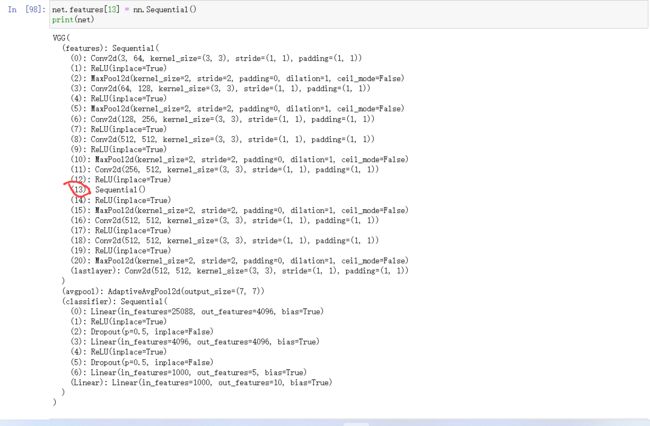pytorch对网络层的增,删, 改, 修改预训练模型结构
#下载模型参数
model.load_state_dict(torch.load('model.pth'))#再加载网络的参数
torch.load('model.pth')是获得网络参数1.我们使用vgg11网络做示例, 看一下网络结构:
加载本地的模型:
vgg16 = models.vgg16(pretrained=False)
#打印出预训练模型的参数
vgg16.load_state_dict(torch.load('vgg16-397923af.pth'))加载库中的模型
import torch
import torch.nn as nn
from torchvision import models
net = models.vgg11(pretrained=True)
print(net)1)(1). 在网络中添加一层:
net网络是一个树型结构, net下面有三个结点,分别是(features, avgpoll, classifier), 我们先在features结点添加一层’lastlayer'层
net.features.add_module('lastlayer', nn.Conv2d(512,512, kernel_size=3, stride=1, padding=1))
print(net) 1)(2). 在classifier结点添加一个线性层:
1)(2). 在classifier结点添加一个线性层:
net.classifier.add_module('Linear', nn.Linear(1000, 10))
print(net)2)(1)修改网络中的某一层(features 结点举例):
net.features[8] = nn.Conv2d(512, 512, kernel_size=(3, 3), stride=(1, 1), padding=(1, 1))
print(net)2)(2)修改网络中的某一层(classifier结点举例):
net.classifier[6] = nn.Linear(1000, 5)
print(net)注意: 这里我尝试对Linear这一层进行更新, 但是Linear名字是字符串, 提取不出来,所以应该在之前添加网络时候, 名字不要取字符串, 否则会报错 ‘ 'str' object cannot be interpreted as an integer’。
3)(1) 网络层的删除(features举例) classifier结点的操作相同。
直接使用nn.Sequential()对改层设置为空即可
net.features[13] = nn.Sequential()
print(net)4)冻结网络中某些层 (直接使该层的requires_grad = False)即可, 这样在反向传播的时候,不会更新该层的参数
#冻结指定层的预训练参数:
net.feature[26].weight.requires_grad = False5). 第二种对网络结构的操作方法:
net.features = nn.Sequential(*list(net.features.children())[:-4])可以看到后面4层被去除了, 就是说可以使用列表切片的方法来删除网络层
net.classifier 对应 net.classifier.children()
net.features 对应 net.features.children()
1. 先加载网络结构
自己的模型, model的类要有定义才可以, 如果在其他.py文件中,可以导入文件,然后用文件中的类实例化对象。
model = torch.load(PATH)2.再加载网络参数
#下载模型参数
model.load_state_dict(torch.load('model.pth'))#再加载网络的参数
torch.load('model.pth')是获得网络参数




